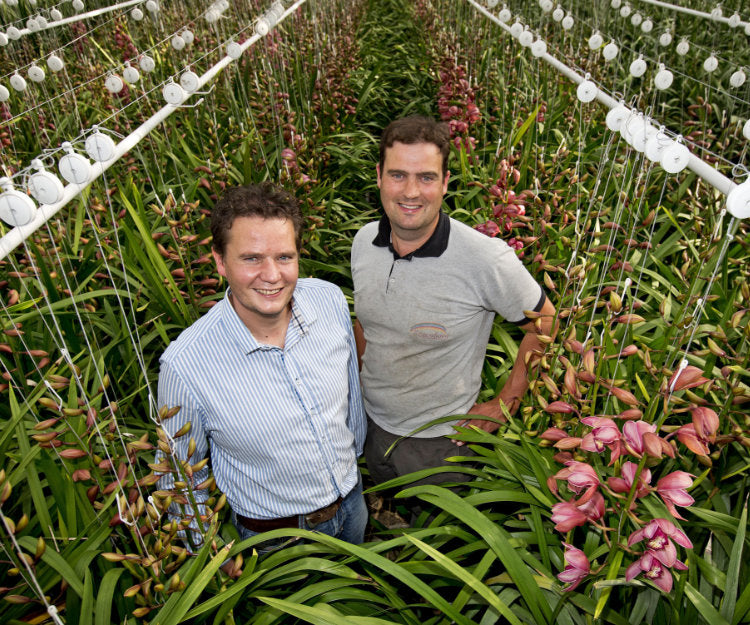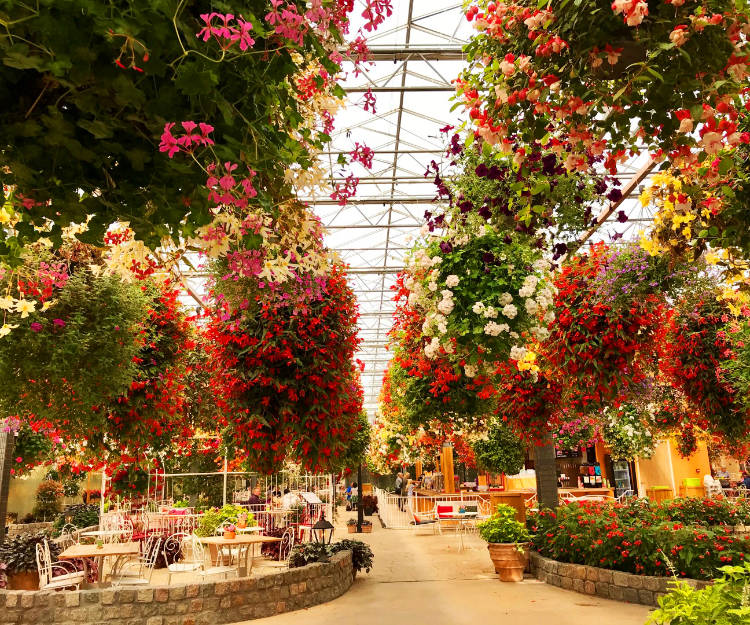
Category Floriculture, Customer Bac Orchids, Duration 2016 – now
Armoured scales in floriculture
-
Transition from chemical to biological
More and more questions reach us from the floriculture sector. They would like to know whether, in addition to chemical intervention, a biological approach is also possible to combat pest insects. One of the reasons is the disappearance of chemical substances, forcing growers to look for biological alternatives. Armoured scales are one of the most difficult pests to control in the cultivation of Cymbidium. Until now, this has been done almost exclusively chemically and often several times a year intervention is necessary to prevent the plants from being ‘run over’. With the help of two Cymbidium growers, we have found a way to successfully combat armoured scales in floriculture.
First experiments with biolgical control agents
In 2016 we were asked about the options to biologically control armoured scales in Cymbidium. We have started a trial with the use of natural enemies at two growers, Bac Orchids and Ben van der Kooij Orchids. The aim was to investigate in practice which control agents are most suitable. We saw that there were two species of armoured scales on Cymbidium at one of the growers: boisduval scale (Diaspis boisduvalli) and oleander scale (Aspidiotis nerii). We have therefore released natural enemies specialized against armoured scales at both locations: the predatory beetles LINDIX and CHILIX and the parasitoids SCALEX-Ec and SCALEX-Am. We started with a biweekly introduction of natural enemies in which five repetitions were applied.
-
Establishment of predatory beetles and parasitoids
After the third introduction, there was little evidence that any of the released natural enemies were established. However, we did find feeding traces of the released LINDIX beetles. It was only after the fourth introduction, about seven weeks after the first introduction, that there was evidence of settlement and that we found a lot of larvae and beetles. We also saw the establishment of released parasitoids on the oleander scale at both growers. SCALEX-Ec in particular was well established on the oleander scale and to a lesser extent we also found SCALEX-Am.
KARNYOTHRIPS as addition
In addition to the beetles LINDIX and CHILIX and the parasitoids SCALEX-Ec and SCALEX-Am, the predatory trips KARNYOTHRIPS has also been released. This predatory thrips is not specialized in cleaning up armoured scales, but it settles at the base of the plant and feeds there on all kinds of insects and mites. In the case of Cymbidium they crawl between the bulbs, where we regularly find them behind the bracts of the bulbs. Hot spots of armoured scales usually occur in this part of the plant. While these narrow spaces are not easily accessible for beetles, KARNYOTHRIPS can access them.
Promising results
The results of 2017 were promising and in 2018 Dico Bac (Bac Orchids) decided to fully implement biological control at his company to get the armoured scales under control.
-
From mid-February onwards, we released LINDIX, KARNYOTHRIPS and both parasitoid species on a weekly basis. In the summer of 2018 it was very hot for a long time. Then LINDIX’s efficiency decreased somewhat. It turned out that, at temperatures of 35 degrees or higher, this predatory beetle is no longer very active. This caused the armoured scales to reappear, but after the warm period LINDIX picked up the control again and the armoured scales decreased in numbers. This shows that LINDIX performs especially well in the cooler months.
Transition to organic cultivation
In 2019, LINDIX proved to be well established and further introduction was no longer necessary. Chemical intervention was no longer necessary to combat the armoured scales. At the company of Gertjan Bac (Bac Orchids), where until then mainly chemical intervention was used to control armoured scale, it was decided at the end of 2019 to also start growing organically. By exchanging plants with his brother Dico, it turned out that there was already a population of LINDIX and parasitoids, so we did not have to put out much extra to get the armoured scale infestation under control.
Biological control armoured scale succesful
This example clearly shows that even difficult pests such as armoured scale can be well controlled with biological control. Dico and Gertjan Bac are very satisfied with the transition to biological control and do not want to go back to the old approach.

Category Vegetable cultivation, Customer GroenlandBiological vegetable cultivation, Duration 2015 – present
Propylea in practice
-
Ladybug larvae combat aphids.
There are many natural enemies that can be used to combat aphids. One of the most popular ones is the two spotted ladybug (Adalia bipunctata). This native ladybug is widely used to combat aphids in avenue trees, but you can also use them under glass to control aphids. Since they can clear many aphids in a short time, it is best to use them when the pest pressure is high. In general, the larvae of this ladybug are released because the adult beetles tend to fly out of the greenhouse.
Spontaneous “in-flyer”.
It can also happen the other way around. A few years ago we received a tip from an organic bell pepper grower where Adalia larvae were regularly released. In the summer a ladybug species had spontaneously flown into the greenhouse and fed enthusiastically on the aphid population.
-
It turned out that this ladybug can establish itself well in the greenhouse: in mid-August there were a lot of ladybug in the greenhouse of this breeder. At that point we were able to collect some of the beetles to do research. It turned out to be the 14-spotted ladybird (Propylea quatuordecimpunctata). This is a native ladybug that you can find throughout the Netherlands.
Breeding the 14-spotted ladybird
We have developed a method to breed the 14-spotted ladybird. As a result, we have been able to supply PROPYLEA to various growers for several years now. In organic pepper cultivation in particular, growers now add PROPYLEA as standard to the arsenal of natural enemies to control aphid populations. This is also the case with Ron van Dijk’s Groenland Biologische Groentekwekerij, which produces organic aubergines, peppers and tomatoes for various European countries and the United States.
-
Application of PROPYLEA in practice.
It is best to introduce adult PROPYLEA beetles early in the season (late February – mid April). Usually it is not necessary to release extra beetles during the season. Experience shows that PROPYLEA is able to establish itself well and will lay eggs as soon as aphids are found in the crop. Even when the aphid is under control, the ladybugs remain in the greenhouse. When the aphid population increases again, we see that PROPYLEA ‘pops up’ again and tackles the aphid problem.
The establishment of PROPYLEA in the greenhouses is a good example of a self-sustaining system to keep the aphid population under control every year.

Category Botanical garden/Zoo, Customer De Orchideeën Hoeve, Duration 2006 – present
De Orchideeën Hoeve
-
In 2006 we have been asked to set up a biological control program in a newly build butterfly garden in Luttelgeest. This new garden is part ofde Orchideeën Hoeve, a complex of several tropical gardens open to public. Up until then the control of harmful insects was done with chemicals and since the gardens were open to public during the day, the pesticide application had to be done during the evenings. However, with the arrival of the butterfly garden, it was no longer possible to apply pesticides, since the butterflies would not survive such a treatment. The biological control of most pests went very well and after a year they were convinced that this was the way to go in the future. In the years that followed, the pests in other gardens have also be controlled in a biological way. More and more animals were introduced in the different gardens and since several years, de Orchideeën Hoeve is not only a tropical garden, but also a zoo.
-
In 2016 the spectacular ‘Floating Flower Garden’ was opened: a flower splendor in a conservatory, which contains over 1400 hanging baskets that hover over your head. Flowers that usually only bloom in summer can be admired here year round. Especially during winter it is quite a challenge to make this happen. Also in this part of de Orchideeën Hoeve were the pests controlled biologically, and that has turned out to be a interesting challenge. Especially in the first year after opening, the control was not optimal. Especially aphids and whitefly caused trouble in spring and early summer, and had to be corrected chemically a few times. It goes without saying that treatments were selected that combine well with a biological approach. Such a treatment does not affect parasitized aphids, so that parasitoids will keep emerging, leading to a big blow for the aphid population (knockdown-effect).
-
Soon after the correction, new natural enemies are released to control the aphid population. Later in the season the effect of biological control improved and in July we saw a turnaround: the pests were finally under control. We often encounter problems like this in new situations. A possible cause is pesticide residues on the newly placed plants, which inhibit the natural enemies. Orchideeën Hoeve currently grows their own plants for the Floating Flower Garden and replaces the plants when they have become too old. Already during the cultivation of the new plants for the Floating Garden, natural enemies are released to combat potential pest insects. This way we tackle the problem from the beginning and get a head start.
